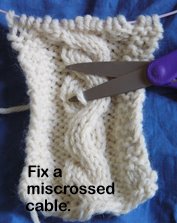Welcome, all.
[blush], and thank you, to those whose comments were compliments.
To those who said they'd NEVER take scissors to their knitting, I say:
The difference, for me, between cutting a steek and this sort of repair, is that the worst thing that can happen with the repair is that you have a couple of extra joins in your yarn (and on a cabled fabric, those are pretty easy to hide....).
If you should have to rip, you could, and you could easily re-knit, because your continuous strand is still there (with a couple of extra joins, one of which you could eliminate, if you had to rip....).
I'm thinking that it would be a major service, on the part of every LYS, to teach basic repairs. Once I understood how the knit fabric *worked* -- how those loops interacted with each other, I was much less worried about dropping a stitch, accidentally, and then was willing to deliberately drop stitches to rip just a small section back to fix a mistake. Similarly, understanding the way the fabric works makes this cable repair less scary.....
As Elizabeth Zimmermann said, I am the boss of my knitting. I recommend her book Knitting without Tears -- if you don't have it, check it out of the library and see, and I bet you'll want to add it to your library.
Tbird, you are right. I assumed the joins, rather than describing them.
What I do, generally, when I join two strands, is work both of them at the same time for two or three stitches, and come back after a few rows and weave in the ends. When I join two balls of yarn in the same project, that's what I usually do.
In this case, what I did was unpick just to the edge of the cable, but I began the kitchenering a couple of stitches further into the knitting. I worked duplicate stitch (in the same row as the cut strand) for a couple of stitches, then kitchenered the ends of the cable, then worked another couple of stitches of duplicate stitch at the other edge of the cable.
With a really slippery yarn, I bet it would be a good idea to have a knot. I've never used a really slippery yarn.... The test yarn was partly wool, and I guarantee you that those joined ends aren't going anywhere. Wool is a nice friendly fiber and wants to help you. It won't sneakily unravel itself, out of sheer meanness.
I urge you to knit a tiny swatch, and cut one thread in the middle. Then pull, pull, pull, viciously, in every direction, and see what happens. It's not anything like nylon stockings, which *zip* a terrible run while you watch in dismay. You may find that one stitch unravels, or two, and maybe one or two will run a few stitches in either direction, but you will need to work to make them do so. With wool in your yarn, I promise you it will be an annoyance rather than a disaster to mend. Not that you want to mend the swatch, though it would be excellent practice for mending a sweater, but *if* you wanted to mend it, it would be relatively easy, as the hole is small.
And now for something completely different.....
These were taken just a few minutes apart. The dark one breaks all the rules about not putting things smack dab in the middle, but I think it works, anyway......



















No comments:
Post a Comment